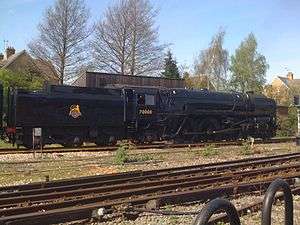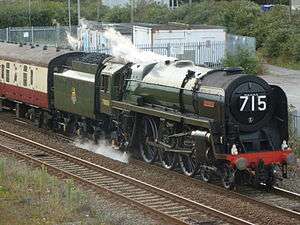BR Standard Class 7 70000 Britannia
|
At Severn Tunnel Junction in 2012 | |||||||||||||||||
| |||||||||||||||||
| |||||||||||||||||
| |||||||||||||||||
| Official Website - Britannia on Icons Of Steam | |||||||||||||||||
British Railways (BR) Standard Class 7 (also known as Britannia class), number 70000 Britannia is a preserved steam locomotive, owned by the Royal Scot Locomotive and General Trust.
British Railways
Britannia was built at Crewe, completed on 2 January 1951. She was the first British Railways standard locomotive to be built and the first of 55 locomotives of the Britannia class. The locomotive was named at a ceremony at Marylebone Station by the then Minister for Transport Alfred Barnes on 30 January 1951.
The BR Locomotive Naming Committee were determined not to use names already in use on other locomotives. They tried to observe this by not selecting the name Britannia for use on 70000 because it was already in use on one of the ex-LMS Jubilee Class locomotives, but Robert Riddles overruled them and the Jubilee had to be renamed.[1]
Britannia was initially based at Stratford (30A) in order to work East Anglian expresses to Norwich and Great Yarmouth, but was also particularly associated with the Hook Continental boat train to Harwich.[2] Subsequently, the loco was based at Norwich Thorpe (w/e 31 January 1959) and March (June 1961) before spending the remainder of her career on the London Midland Region: Willesden (1A) (w/e 30 March 1963), Crewe North (5A) (w/e 25 May 1963), Crewe South (5B) (w/e 19 May 1965) and finally Newton Heath (9D) (w/e 5 March 1966) from where she was withdrawn w/e 28 May 1966,[3]
The locomotive pulled the funeral train of King George VI from King's Lynn, Norfolk to London following his death in February 1952 at Sandringham House, Norfolk.[4] For this task, Britannia had her cab roof painted white, as was the custom with royal locomotives (B2 61617 Ford Castle, which pulled the train from Wolferton Station to King's Lynn, was similarly liveried). Britannia has also worn the white roof in preservation.
Britannia was withdrawn in May 1966, after 15 years of service.[5]
Preservation

Initially destined for the National Railway Museum because of her cultural significance, she was stored. However, due to her prototype design and construction differences, the NRM chose standard sister 70013 Oliver Cromwell, instead. Britannia was eventually bought by Britannia Locomotive Company Ltd.
After a series of moves, she was eventually returned to steam on the Severn Valley Railway, where she remained for a number of years in operational but non-mainline condition. With the society wishing to make more use of the locomotive, she was moved to the European gauge Nene Valley Railway in Peterborough, where she was also fitted with an air-brake compressor, and was based there from 1980-2000. Britannia made her return to the main line on 27 July 1991, successfully working enthusiast trips until 1997, and was featured in an episode of London's Burning.

With an expired mainline boiler certificate, due to the high cost of refurbishment, the locomotive was sold to Pete Waterman in 2000. Stored at Waterman's workshops at the Crewe Heritage Centre, after initial assessment the amount of work resulted in Waterman selling her to Jeremy Hosking. The locomotive underwent restoration at Crewe which involved a newly refurbished cab, a new smoke box and major work on the boiler; replacement steel sides, new crown stays, new front section barrel section, new steel and copper tubeplate, repairs and patches to door plate and major work to copper firebox.
Transferred to the Royal Scot Locomotive and General Trust (RSL>), the locomotive was returned to main line operational condition in 2011, initially out shopped in its prototype black British Railways livery (where it did not have nameplates fitted, as was thus known by railway convention as 70000). After a running-in period, in 2012 the locomotive was repainted in British Railways Brunswick Green, but with an early BR crest (unlike her sister 70013 Oliver Cromwell which carries BR's Late Crest). On 24 January 2012, the loco hauled the Royal Train with Prince Charles on board to Wakefield Kirkgate, where he rededicated the locomotive. For the trip the loco again had a painted white cab roof, removed after the engine's appearance at the West Somerset Railway's Spring Gala.
References
- ↑ Itinerary dated 8 October 1993, Queen of Scots Train.
- ↑ Swinger, Peter (1987). Britannia No. 70000. Shepperton: Ian Allan. p. 6. ISBN 0-7110-1761-1.
- ↑ "BRDatabase: Britannia". BR Database. Retrieved 2011-07-19.
- ↑ Harrington, Ralph (3 June 2002). "Royal arrivals and departures, 1901-1953". Railway Readings: excerpts from the railway press from the 1840s to the 1990s. The University of York Institute of Railway Studies and Transport History.
- ↑ "Britannia 7MT Class". Kent Rail. Retrieved 2010-06-20.
